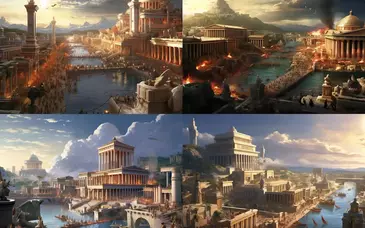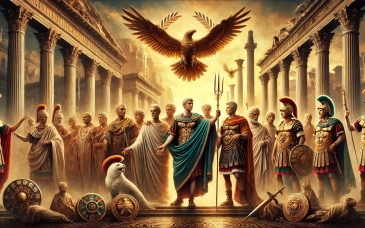The Roman Navy was always considered an inferior arm and was strictly under army control. But the, Romans proved itself capable of launching a fleet capable of checking an established naval power such as Carthage.
Romans were no sailors though. They had no knowledge of ship building. Their ships were in fact built copying the example of captured Carthaginian vessels, combined with the expertise supplied by the Greek cities of southern Italy.
Rather unexpected success in battle was obtained by a logical Roman idea that a warship was little more than a floating platform on which the soldiers could be brought into close contact with the enemy.
For this purpose they invented a huge boarding plank with a large spike on the end, which could be raised and lowered like a drawbridge. Before battle it would be raised and then dropped onto an enemy's deck. The spike would embed itself into the opponent's deck planking and the legionaries could board the enemy vessel across it. This elaborate contraption was called 'the raven' (corvus) This invention gave Rome five victories at sea. However, it is believed that it's weight, carried above the water line, also made the ships unstable, and could in rough seas cause them to capsize.
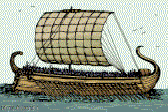
The (classis) (naval fleet) provided the Roman army with sea power and logistical support. Initially, ancient Romans had no great love of the sea. It was during the first Punic War that it became a necessary for a strong navy to be built. Rome were surrounded by other Mediterranean nations who had already had large fleets and much experience in seafaring. The Romans relied on the accomplishments of foreign navies in developing their own.
Contrary to popular belief, the navy did not use slaves. The rowers, sailors and soldiers were auxiliaries receiving citizenship after serving for 26 years. Though most came from a seafaring community, this was not a requisite to join. The officers came from the Roman equestrian class. In Imperial times they often were freedmen from the Imperial household.

An ancient galley (originally Greek, afterwards also Roman) with three ranks of oars one above another, used chiefly as a ship of war. This is the main type of the warship of Mediterranean. Some researchers attribute the invention of trireme to Phoenicians, other name Corinthian Amenocc. The main weapon of trireme was battering ram - a prolongation of a keel beam. The displacement of a vessel reached 230 tons, length - 45 meters. The oars on triremes were of various length. Most strong oarsmen were placed on the upper deck. It was high-paid and privileged caste. Oarsmen of an average and lower ranks named differently. The commander of a trireme was trierarch. To him were obeyed helmsman and oarsmen chief - hortator (one who exhorts or encourages). The rate of movement of a trireme on oars came to 7 - 8 knots, but all three ranks of oars worked only during the fight.
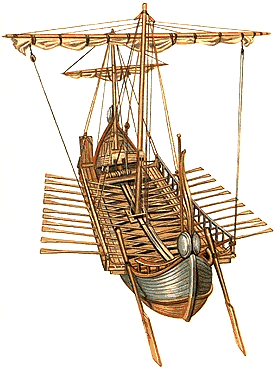
A Roman Liburna
The crew of a Liburnia consisted of about 50-80 oar-men (remiges) and a unit of about 30-50 marines, depending on the size of the ship. Liburnias were used everywhere in the roman empire, for example on the Nile, Rhine and Danube rivers. The Liburnia was a powerful ship especially when ramming an enemy ship. With a closed deck it could take more marines as any other ship this size for the purpose of hand to hand combat helping insure a victory when fighting at close quarters with a ship of the same size.
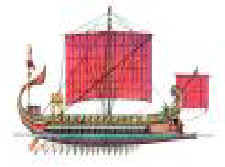
In effect, much of this achievement of their sea victories was minimized by the losses the Romans hence suffered at sea. Partially the raven might well be responsible for some of these losses. But generally it was the inept way the Romans handled their vessels as well as their ill fortune in running into several tempests.
It is possible that Rome's losses at sea through lack of seamanship and ignorance of navigation had Rome rely completely on the Greek cities to provide ships when they were required. But as Rome gained control of the lands of the eastern Mediterranean, the sea power of the Greek cities declined. Suddenly making Rome the most powerful sea power in its region.
Our Next Stop Will Be the Ancient Viking Museum in Sweden , Today We Will be visiting the Ancient Trades and Raids Department.
